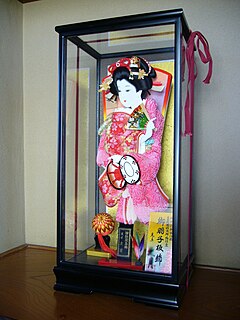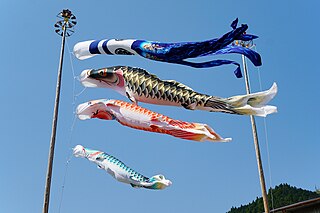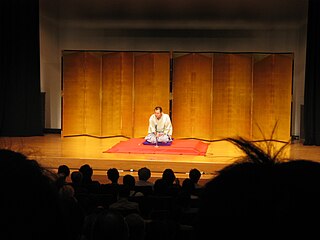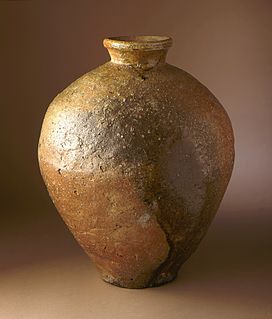 W
WAkabeko is a legendary cow from the Aizu region of Japan, who inspired a traditional toy. Aizu legend claims that the toys are based on a real cow used to build the Enzō-ji temple of Yanaizu in the ninth century.
 W
WThe Aomori Nebuta Matsuri is a Japanese summer festival that takes place in Aomori, Aomori Prefecture, Japan in early August. The festival attracts the most tourists of any of the country's nebuta festivals, and is counted among the three largest festivals in the Tōhoku region. It was designated an Important Intangible Folk Cultural Property in 1980, and as one of the 100 Soundscapes of Japan by the Ministry of the Environment in 1996.
 W
WThe traditional lighting equipment of Japan includes the andon (行灯), the bonbori (雪洞), the chōchin (提灯), and the tōrō (灯篭).
 W
WA Daruma doll is a hollow, round, Japanese traditional doll modeled after Bodhidharma, the founder of the Zen tradition of Buddhism. These dolls, though typically red and depicting a bearded man (Bodhidharma), vary greatly in color and design depending on region and artist. Though considered a toy by some, Daruma has a design that is rich in symbolism and is regarded more as a talisman of good luck to the Japanese. Daruma dolls are seen as a symbol of perseverance and good luck, making them a popular gift of encouragement. The doll has also been commercialized by many Buddhist temples to use alongside the setting of goals.
 W
WFukusuke (福助) are traditional china dolls associated with good luck in Japan. A Fukusuke doll is the depiction of a man kneeling seiza style, with a large head and a topknot. It was originally a doll enshrined in tea houses or brothels in the Edo period to bring good luck. In those days, it was considered that Fukusuke would bring "perennial youth, wealth and honor".
 W
WHagoita are the wooden paddles used to hit shuttlecocks, traditionally made of soapberry seeds and bird feathers, that are used to play the traditional Japanese pastime called hanetsuki during the New Year. The paddles are decorated with various images, sometimes executed in relief, of women in kimono, kabuki actors, and so on. Japanese people think playing hanetsuki is a way to drive away evil spirits because the movement of the hagoita is similar to the harau action. Thus playing hanetsuki with hagoita is often used as a charm against evil.
 W
WHyottoko (火男) is a comical Japanese character, portrayed through the use of a mask. His mouth is puckered and skewed to one side. Some masks have different eye sizes between the left and right eyes. He is often wearing a scarf around his head. There is a similar character for women called Okame (阿亀) or Otafuku (阿多福).
 W
WA mikoshi (神輿) is a sacred religious palanquin. Shinto followers believe that it serves as the vehicle to transport a deity in Japan while moving between main shrine and temporary shrine during a festival or when moving to a new shrine. Often, the mikoshi resembles a miniature building, with pillars, walls, a roof, a veranda and a railing.
 W
WKogin-zashi is one of the techniques of sashiko, or decorative reinforcement stitching, that originated in the part of present-day Aomori Prefecture, Japan, that was controlled by the Tsugaru clan during the Edo period. It is also referred to as sashi-kogin. It is generally made with white cotton embroidery in diamond patterns on blue linens. During the Edo period, peasants were not permitted to wear cotton cloth in the Tsugaru region, so cotton thread was added to linen cloth with the aim of bypassing these regulations and making clothes more protective during the harsh winter weather, as well as strengthening the cloth.
 W
WKoinobori (鯉のぼり), meaning "carp streamer" in Japanese, are carp-shaped windsocks traditionally flown in Japan to celebrate Tango no sekku (端午の節句), a traditional calendrical event which is now designated a national holiday: Children's Day. These windsocks are made by drawing carp patterns on paper, cloth or other nonwoven fabric. They are then allowed to flutter in the wind. They are also known as satsuki-nobori (皐のぼり).
 W
WKokeshi , are simple wooden dolls with no arms or legs that have been crafted for more than 150 years as a toy for children. Japanese dolls, originally from the northeastern region (Tōhoku-chihō) of Japan. They are handmade from wood, have a simple trunk and head with a few thin, painted lines to define the face. The body often has floral and/or ring designs painted in red, black, and sometimes green, purple, blue, or yellow inks, and covered with a layer of wax. One characteristic of kokeshi dolls is their lack of arms or legs. Since the 1950s, kokeshi makers have signed their work, usually on the bottom and sometimes on the back.
 W
WKumihimo (組み紐) is a traditional Japanese artform of making braids and cords. Literally meaning "gathered threads", kumihimo are made by interlacing reels of yarn, commonly silk, with the use of traditional, specialised looms - either a marudai (丸台) or a takadai (高台).
 W
WThe Maneki-neko is a common Japanese figurine which is often believed to bring good luck to the owner. In modern times, they are usually made of ceramic or plastic. The figurine depicts a cat, traditionally a calico Japanese Bobtail, with a paw raised in a Japanese beckoning gesture. The figurines are often displayed in shops, restaurants, pachinko parlors, dry cleaners, laundromats, bars, casinos, hotels, nightclubs, and other businesses, generally near the entrance. Some Maneki-neko are equipped with a mechanical paw which slowly moves back and forth.
 W
WMiharu-goma (三春駒) are angular, brightly coloured, wooden toy horses produced as a folk art in Miharu, Fukushima, Japan.
 W
WA mikoshi (神輿) is a sacred religious palanquin. Shinto followers believe that it serves as the vehicle to transport a deity in Japan while moving between main shrine and temporary shrine during a festival or when moving to a new shrine. Often, the mikoshi resembles a miniature building, with pillars, walls, a roof, a veranda and a railing.
 W
WThe concept of mingei (民芸), variously translated into English as "folk craft", "folk art" or "popular art", was developed from the mid-1920s in Japan by a philosopher and aesthete, Yanagi Sōetsu (1889–1961), together with a group of craftsmen, including the potters Hamada Shōji (1894–1978) and Kawai Kanjirō (1890–1966). As such, it was a conscious attempt to distinguish ordinary crafts and functional utensils from "higher" forms of art – at the time much admired by people during a period when Japan was going through rapid westernisation, industrialisation, and urban growth. In some ways, therefore, mingei may be seen as a reaction to Japan's rapid modernisation processes.
 W
WNamahage (生剥) in traditional Japanese folklore is a demonlike being, portrayed by men wearing hefty oni (ogre) masks and traditional straw capes (mino) during a New Year's ritual of the Oga Peninsula area of Akita Prefecture in northern Honshū, Japan.
 W
WAn oil-paper umbrella is a type of paper umbrella that originated in China. It subsequently spread across several East, South and Southeast Asian countries such as Japan, Korea, Malaysia, Myanmar, Thailand and Laos, where it has been further developed with different characteristics.
 W
WŌtsu-e was a folk art that began in 17th century Japan and depended on the busy road traffic of the trade route through the district where it was produced. With the coming of railways in the late 19th century, it largely disappeared.
 W
WRakugo is a form of Japanese verbal entertainment of yose. The lone storyteller sits on a raised platform, a kōza (高座). Using only a paper fan and a small cloth as props, and without standing up from the seiza sitting position, the rakugo artist depicts a long and complicated comical story. The story always involves the dialogue of two or more characters. The difference between the characters is depicted only through change in pitch, tone, and a slight turn of the head.
 W
WRice paddy art is an art form originating in Japan where people plant rice of various types and colors to create images in a paddy field.
 W
WSashiko is a type of traditional Japanese embroidery or stitching used for the decorative and/or functional reinforcement of cloth and clothing. Owing to the relatively cheap nature of white cotton thread and the abundant nature of cheap, indigo-dyed blue cloth in historical Japan, sashiko has a distinctive appearance of white-on-blue embroidery, though some decorative pieces may also use red thread.
 W
WShigaraki ware (信楽焼) is a type of stoneware pottery made in Shigaraki area, Japan. The kiln is one of the Six Ancient Kilns in Japan. Although figures representing the tanuki are a popular product included as Shigaraki ware, the kiln and local pottery tradition has a long history.
 W
WShisa is a traditional Ryukyuan cultural artifact and decoration derived from Chinese guardian lions, often seen in similar pairs, resembling a cross between a lion and a dog, from Okinawan mythology. In magic typology, they are sometimes also classified as gargoyle beasts. Shisa are wards, believed to protect from some evils. People place pairs of shisa on their rooftops or flanking the gates to their houses, with the left shisa traditionally having a closed mouth, the right one an open mouth. The open mouth shisa traditionally wards off evil spirits, and the closed mouth shisa keeps good spirits in.
 W
WTemari (手まり) balls are a folk art form and Japanese craft, originating in China and introduced to Japan around the 7th century A.D. "Temari" means "hand ball" in Japanese. Balls made from embroidery may be used in handball games and other such similar games. An accessory similar in appearance, but with the addition of a hand-strap and a tassel, can serve as an accessory for a kimono; a kimono bag.
 W
WA handheld fan, or simply hand fan, may be any broad, flat surface that is waved back-and-forth to create an airflow. Generally, purpose-made handheld fans are folding fans, which are shaped like a sector of a circle and made of a thin material mounted on slats which revolve around a pivot so that it can be closed when not in use.